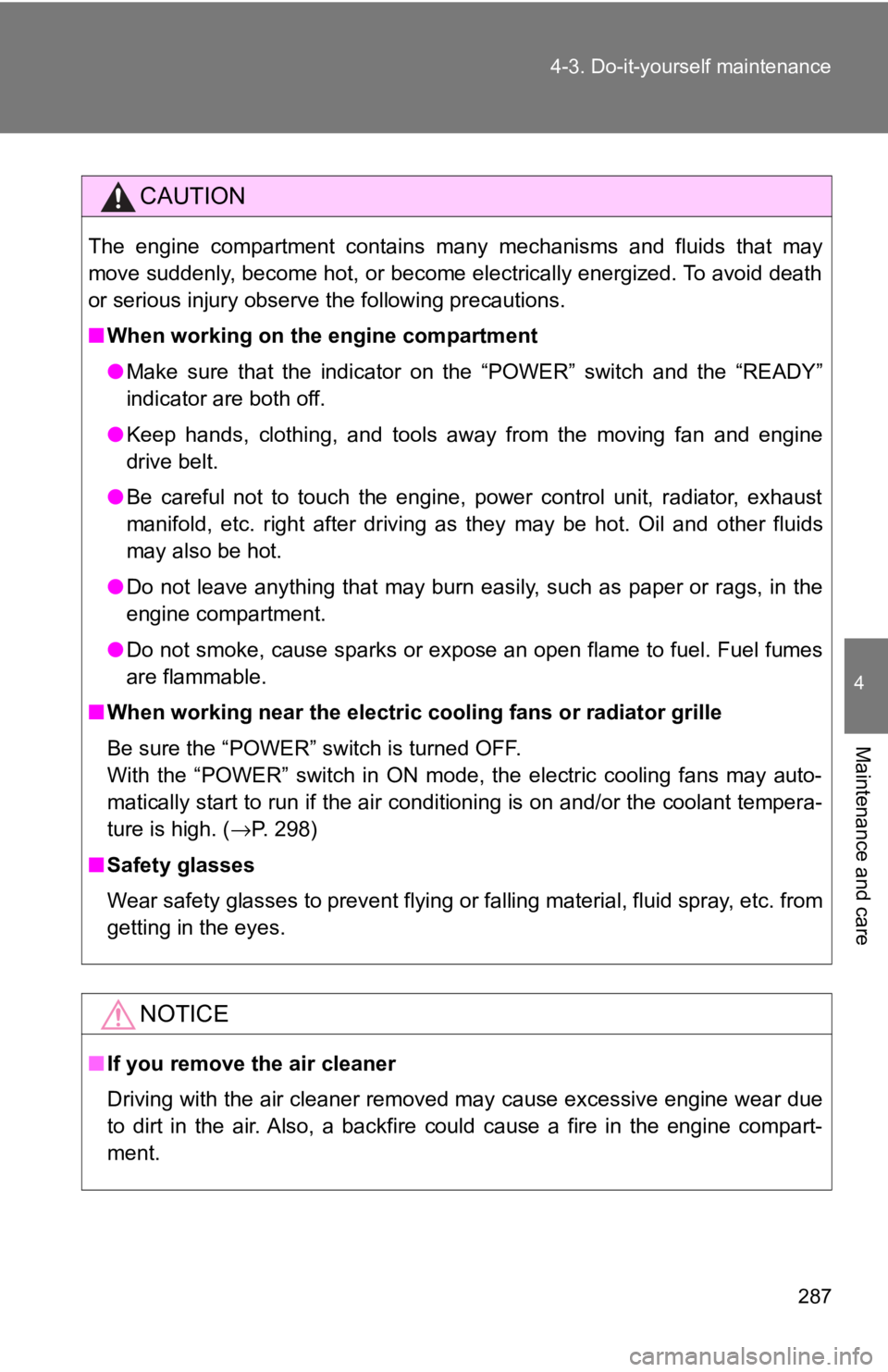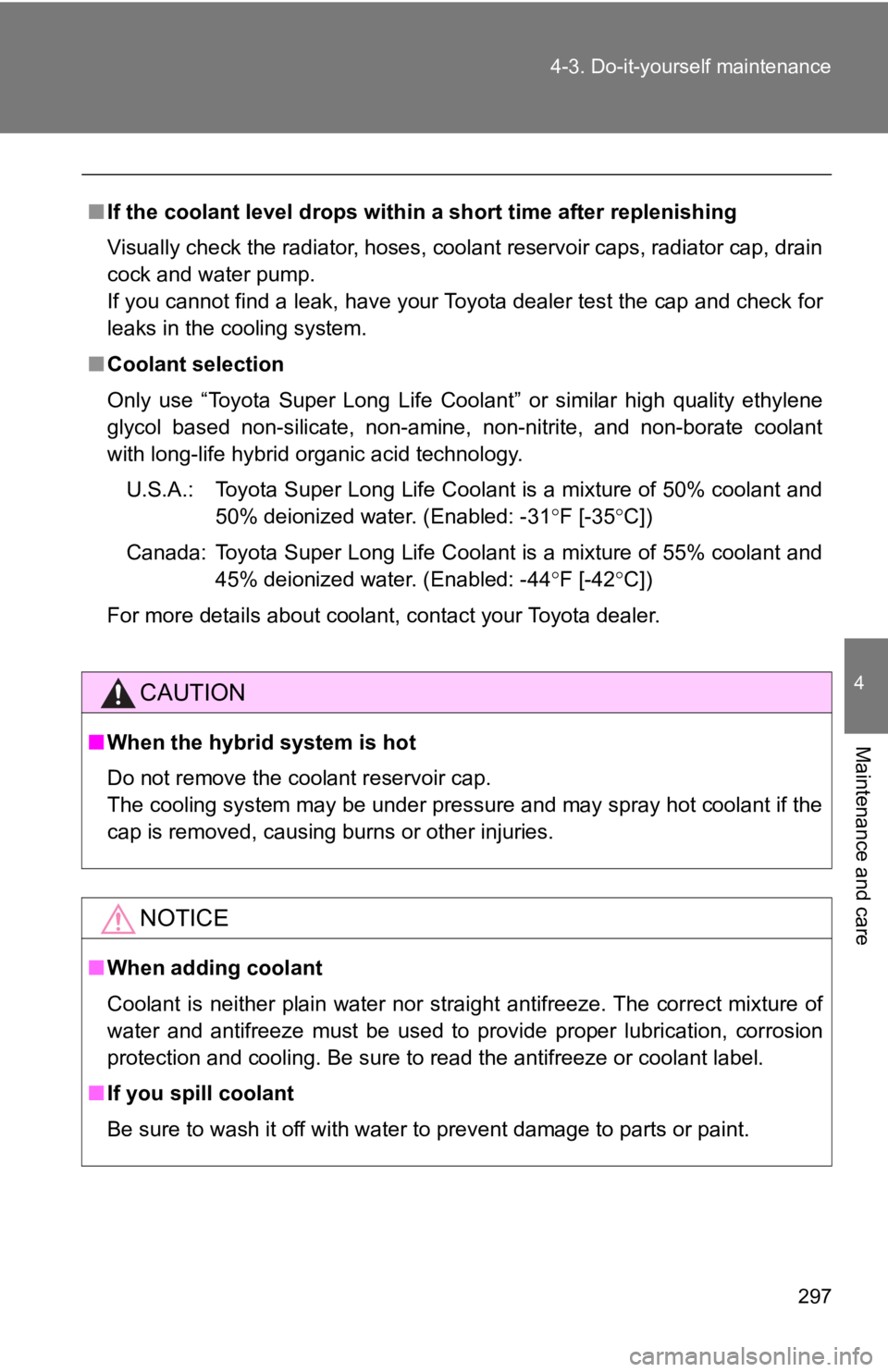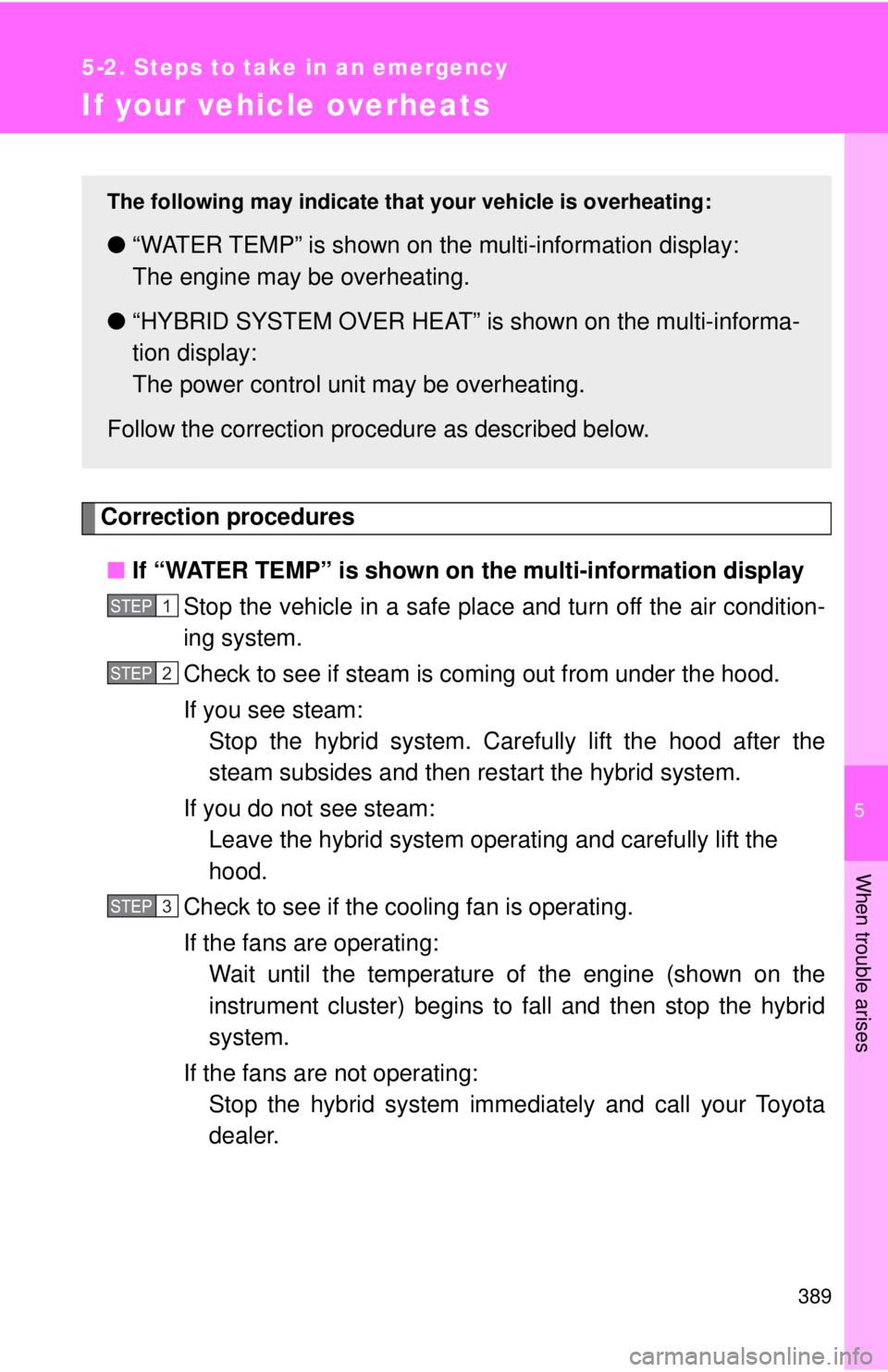Page 24 of 444

24 1-1. Hybrid system
●To help prevent the 12-volt battery from becoming discharged, drive the
vehicle at least once a month, and operate the accessories only when
the “READY” indicator is on. When parking the vehicle, make sure the
doors and trunk are closed and all lights are turned off.
■ After the 12-volt battery has di scharged or has been changed or
removed
The gasoline engine may not stop even if the vehicle is running on the hybrid
battery (traction battery). If this continues for a few days, contact your Toyota
dealer.
■ Sounds and vibrations specific to a hybrid vehicle
There may be no engine sounds or vibration even though the vehicle is able
to move. Always put the shift lever in P when parked.
The following sounds or vibrations may occur when the hybrid system is
operating, and are not a malfunction:
●Motor sounds may be heard from the engine compartment.
● Sounds may be heard from the hybrid battery (traction battery) behind
the rear seat when the hybrid system starts or stops.
● Sounds may be heard from the transaxle when the hybrid system starts
or stops, or while the vehicle is idling.
● Engine sounds may be heard when accelerating sharply.
● Sounds may be heard due to the regenerative braking when you press
the brake pedal.
● Vibration may be felt when the gasoline engine starts or stops.
● Cooling fan sounds may be heard from the air intake vents behind the
rear seat.
■ Maintenance, repair, recycling, and disposal
Contact your Toyota dealer regarding maintenance, repair, recycling and dis-
posal. Do not dispose of the vehicle yourself.
Page 26 of 444
26 1-1. Hybrid system
■Hybrid battery air vent
There is an air intake vent on the
package tray for the purpose of
cooling the hybrid battery (trac-
tion battery). If the vent becomes
blocked, the hybrid battery may
overheat, leading to a reduction in
hybrid battery output.
Emergency shut off system
The emergency shut off system bloc ks off the high voltage current
and stops the fuel pump to minimize the risk of electrocution and fuel
leakage when a certain level of impa ct is detected by the impact sen-
sor. If the emergency shut off syste m activates, your vehicle will not
restart. To restart the hybrid sy stem, contact your Toyota dealer.
Energy monitor/consumption screen
You can view the status of your
hybrid system on the multi-infor-
mation display (→P. 145) and the
navigation system screen*
( → P. 27, 29).
The following images are exam-
ples only, and may vary slightly
from actual conditions.
*: Vehicles with Navigation System
Page 287 of 444

287
4-3. Do-it-yourself maintenance
4
Maintenance and care
CAUTION
The engine compartment contains many mechanisms and fluids that may
move suddenly, become hot, or become electrically energized. To avoid death
or serious injury observe the following precautions.
■
When working on the engine compartment
●Make sure that the indicator on the “POWER” switch and the “READY”
indicator are both off.
● Keep hands, clothing, and tools away from the moving fan and engine
drive belt.
● Be careful not to touch the engine, power control unit, radiator, exhaust
manifold, etc. right after driving as they may be hot. Oil and other fluids
may also be hot.
● Do not leave anything that may burn easily, such as paper or rags, in the
engine compartment.
● Do not smoke, cause sparks or expose an open flame to fuel. Fuel fumes
are flammable.
■ When working near the electric c ooling fans or radiator grille
Be sure the “POWER” switch is turned OFF.
With the “POWER” switch in ON mode, the electric cooling fans may auto-
matically start to run if the air conditioning is on and/or the coolant tempera-
ture is high. ( →P. 298)
■ Safety glasses
Wear safety glasses to prevent flying or falling material, fluid spray, etc. from
getting in the eyes.
NOTICE
■If you remove the air cleaner
Driving with the air cleaner removed may cause excessive engine wear due
to dirt in the air. Also, a backfire could cause a fire in the engine compart-
ment.
Page 291 of 444
291
4-3. Do-it-yourself maintenance
4
Maintenance and care
Engine compartment
Brake fluid reservoir(→ P. 298)
Engine oil filler cap (→ P. 293)
Engine oil level dipstick (→ P. 292)
Power control unit coolant
reservoir ( →P. 296)
Engine coolant
radiator ( →P. 298)Fuse box ( →P. 325)
Condenser ( →P. 298)
Electric cooling fans
Power control unit coolant
radiator ( →P. 298)
Washer fluid tank ( →P. 299)
Engine coolant reservoir (→ P. 296)
Page 297 of 444

297
4-3. Do-it-yourself maintenance
4
Maintenance and care
■
If the coolant level drops within a short time after replenishing
Visually check the radiator, hoses, coolant reservoir caps, radiator cap, drain
cock and water pump.
If you cannot find a leak, have your Toyota dealer test the cap and check for
leaks in the cooling system.
■ Coolant selection
Only use “Toyota Super Long Life Coolant” or similar high quality ethylene
glycol based non-silicate, non-amine, non-nitrite, and non-borate coolant
with long-life hybrid organic acid technology.
U.S.A.: Toyota Super Long Life Coolant is a mixture of 50% coolant and 50% deionized water. (Enabled: -31 °F [-35° C])
Canada: Toyota Super Long Life Coolant is a mixture of 55% coolant and 45% deionized water. (Enabled: -44 °F [-42° C])
For more details about coolant, contact your Toyota dealer.
CAUTION
■ When the hybrid system is hot
Do not remove the coolant reservoir cap.
The cooling system may be under pressure and may spray hot coolant if the
cap is removed, causing burns or other injuries.
NOTICE
■When adding coolant
Coolant is neither plain water nor straight antifreeze. The correct mixture of
water and antifreeze must be used to provide proper lubrication, corrosion
protection and cooling. Be sure to read the antifreeze or coolant label.
■ If you spill coolant
Be sure to wash it off with water to prevent damage to parts or paint.
Page 330 of 444
330 4-3. Do-it-yourself maintenance
20 EFI NO.310 AFuel tank system, multiport fuel
injection system/sequential multi-
port fuel injection system
21 IGCT No.2 10 A Hybrid system ECU, motor genera-
tor ECU
22 INV W/P 15 AHybrid system ECU, hybrid battery
(traction battery), DC/DC converter,
multiport fuel injection system/
sequential multiport fuel injection
system
23 S-HORN 7.5 A No circuit
24 A/F 20 A No circuit
25 MPX-B 10 A Gauges and meters
26 EFI NO.1 10 A Smart key system
27 HORN 10 A Horns
28 H-LP(RL) 15 A Right-hand headlight (low beam)
29 H-LP(LL) 15 A Left-hand headlight (low beam)
30 H-LP(RH) 15 A Right-hand headlight (high beam)
31 H-LP(LH) 15 A Left-hand headlight (high beam)
32 HTR 50 A Air conditioning system
33 HTR SUB2 50 A PTC heater
34 HTR SUB1 50 A PTC heater
35 RR DEF 50 ARear window defogger, “MIR HTR”
fuse
36 CDS FAN 40 A Electric cooling fan
37 RDI FAN 40 A Electric cooling fan
FuseAmpereCircuit
Page 388 of 444
388 5-2. Steps to take in an emergency
NOTICE
■When handling jumper cables
Be careful that the jumper cables do not become tangled in the cooling fans
or any of the belts when connecting or disconnecting them.
Page 389 of 444

5
When trouble arises
389
5-2. Steps to take in an emergency
If your vehicle overheats
Correction procedures■ If “WATER TEMP” is shown on the multi-information display
Stop the vehicle in a safe plac e and turn off the air condition-
ing system.
Check to see if steam is coming out from under the hood.
If you see steam: Stop the hybrid system. Carefully lift the hood after the
steam subsides and then restart the hybrid system.
If you do not see steam: Leave the hybrid system operating and carefully lift the
hood.
Check to see if the cooling fan is operating.
If the fans are operating: Wait until the temperature of the engine (shown on the
instrument cluster) begins to fall and then stop the hybrid
system.
If the fans are not operating: Stop the hybrid system imme diately and call your Toyota
dealer.
The following may indicate that your vehicle is overheating:
● “WATER TEMP” is shown on the multi-information display:
The engine may be overheating.
● “HYBRID SYSTEM OVER HEAT” is shown on the multi-informa-
tion display:
The power control unit may be overheating.
Follow the correction procedure as described below.
STEP1
STEP2
STEP3